Home | City Notes | Restaurant Guide | Galleries | Site Map | Search | Contact
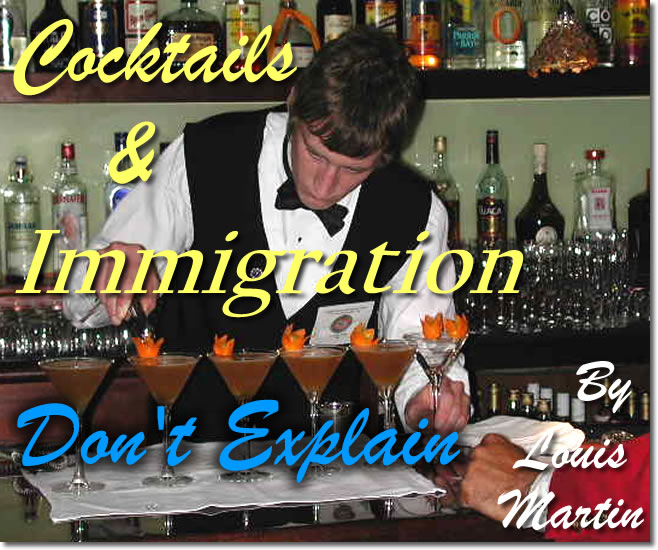
Just can't stay in on a Friday night. In fact can't stay in Friday afternoon. Usually head out three or four. Start with Chelsea Place on Bush street to check in with the Fong Lady, aka Fawn, who is gentle, thoughtful, likeable but, in her own words "lazy." But, she always adds, "I get the job done." And she does. I don't think of her so much as lazy as liking to avoid trouble. She likes the good life but doesn't want to fight anyone over it. Sound reasonable? How sweet life would be if others had this attitude. She fixes me a Wild Turkey Manhattan with bitters I bring from home. Most of Chelsea's customers drink Whiskey or beer or both; it's a limited bar. For fancy drinks I go to Enrico's. Still I like visiting the Fong Lady.
Got an invitation from Dave Nepove, master
mixologist at Enrico's, to attend the United States Bartending
Guild competition. Dave is also treasurer of the 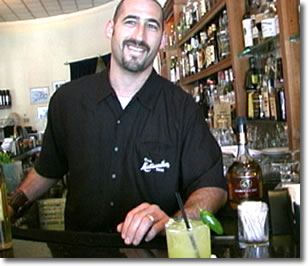 San
Francisco Bartenders Guild, which is part of a world-wide organization,
says Dave, "geared
toward creating a sense of camaraderie among bartenders and spirit companies
to create well made cocktails." Encouraging creativity is part of
the reason for the organization as well. They encourage members to go
beyond just "regurgitating
classic recipes."
San
Francisco Bartenders Guild, which is part of a world-wide organization,
says Dave, "geared
toward creating a sense of camaraderie among bartenders and spirit companies
to create well made cocktails." Encouraging creativity is part of
the reason for the organization as well. They encourage members to go
beyond just "regurgitating
classic recipes."
Says Jacques Bezuiedenhout, current president of the San Francisco Bartenders Guild, the guild is for "people who are very serious about their profession as a bartender, people who want to take it further and talk about cocktails or learn more about spirits."
As anyone knows who has drunk their way around The City, there are good bartenders and there are so-so bartenders, and even bad ones. As Dave Nepove points out, many bartenders regard their jobs as temporary; they are simply between jobs. But not so with the real bartender. The real bartender is passionate about making quality drinks—drinks with the highest quality ingredients and drinks that are fresh, refreshing, and original. There is, however, one other quality of the real bartender: He or she is also part therapist; he or she is a compassionate and non-judgmental listener. With such a bartender, you go home feeling better about life and yourself, and it is not due just to the drink. Such a bartender ministers to body and mind and soul.
I remember once going into Enrico's about three o'clock in the afternoon on a Wednesday. There was Dave in back of the bar with a big grin. "What have you been up to?" he asked. I hung my head a little, then told him the truth: "I've been down at Centerfolds."
"Well, a guy needs to do that now and then," Dave said in a booming voice. "What would you like to drink?" I wasn't quite sure but said Kettle One Martini.
"Beautiful," said Dave, as though I had picked the drink of the day.
See the point? I had not only been doing the right thing down there at Centerfolds, I had ordered the perfect drink. I went home feeling better.
The bar competition took place on Sunday over at Bar 15 Romolo in North Beach. It's just up the alley from the Hungry i on Broadway, one of the old-time strip joints in North Beach featuring "The Best Girls in Town." I didn't know if there are better girls in town or not, but they are okay by me.
Now a bar competition you might think to be a lively event with a lot of laughter and gaiety. But not in the City of San Francisco, where drinks and the skillful making of them are taken seriously. True, there was good humor but it was a solemn and serious event. It was a little like watching a game of pool where the stakes are high.
Each competitor got seven minutes to prepare five versions of the same drink. One judge sat at the right side of the bar calling off the minutes and noting any technical errors such as spills or drips. Three other judges, doing a blind tasting, sat behind a curtain on the other side of the room. There was a small audience that sat in a circle around the bar. Any conversations were muted, as though taking place in a library. When the cocktails were complete, the bartender held one up for inspection and the audience applauded politely.
The stakes were these: Representing the United States,
the winner got to go onto the world championship held in Helsinki, Finland
in February. On Sunday it was the finals for selecting the United States
representative, and the three United States finalists were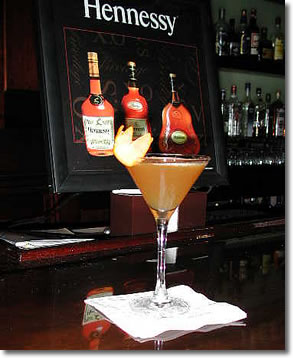 there:
Fred Ireton from Long Beach, Sean Bigley from Las Vegas, and Thomas Waugh
from San Francisco. Thomas is a bartender
at the Harry Denton's Starlight Room. All these guys know their drinks
but it turned out the youngest bartender, Thomas Waugh, won the day with "The
Knack." Based on Hennessy
cognac and served in a small, elegant glass garnished with a miniature
orange carved to look like a crown, it was indeed one classy drink.
there:
Fred Ireton from Long Beach, Sean Bigley from Las Vegas, and Thomas Waugh
from San Francisco. Thomas is a bartender
at the Harry Denton's Starlight Room. All these guys know their drinks
but it turned out the youngest bartender, Thomas Waugh, won the day with "The
Knack." Based on Hennessy
cognac and served in a small, elegant glass garnished with a miniature
orange carved to look like a crown, it was indeed one classy drink.
As a judge in the final round of the competition, I carefully and fairly rated the drinks for presentation, taste, and "overall impression," then downed Thomas' drink with great pleasure.
But enough about bars and bartender competitions. There's more going on in San Francisco than booze, its preparation and consumption.
She who was lost has been found, and guess where? In a bar on Union and Grant. I used to catch Nina at the Hungry i where she tended bar. She was much more interesting than the "girls" and a knock-out babe even fully clothed. Believe it or not, we talked about life and its meaning while breasts were bared on stage and bodies gyrated and boozed-up guys handed over their money to the girls. She explained the girls to me, both collectively and individually. They like to be treated like movie stars, she says. I like this explanation but there may be more to it than that. Then for six months she was "missing" in the City of Oakland. But the other day, cruising Broadway, I heard rumors from Dwayne, manager of the Hungry i, that the famous lady was back. Try Show Girls or Grant & Union Saloon, he said. I struck out at Show Girls, didn't want to go in anyway, then fled up to Grant and split down to Union. The joint was packed with Saturday night revelers and a band was wailing but there was my lovely lady of African and Puerto Rican blood in back of the bar steaming up the place. She slipped around the end of the bar to embrace—it had been six months or more—and as I grabbed her for a big open-arms hug, she turned slightly and instead of grabbing her shoulder with my right hand I grabbed her left breast. It was nice but not what I had in mind; and she, being a smart lady and very cool, understood how it happened and smiled her enigmatic smile and we pursued more oblique matters. So good to see this hot kid back in town. She makes my blood boil in the nicest way. She's my high spiritual baby; it's nice to know she has buoyancy again. Because she who was lost had been found, he who had died was alive again this Saturday evening. Alleluia!
To calm my blood, the next day I paid Harry Volk a visit at the Weinstein's Kipniss Gallery on Geary. Know the work of Robert Kipniss? It's interesting stuff. A lot of discipline, a lot of work goes into each piece. He is known for mezzotints and lithographs and for the sometimes eeriness of his expression. But talking about his work does not work. You have to see it, you have to get lost in it. You may not feel warm and fuzzy when you look at Kipniss but you feel in touch with something deep. He is "sobering" as a strong cup of coffee, and in the city of San Francisco that may occasionally be a good thing.
Harry, who knows how to be calm, tells me that he owns a few Kipniss pieces himself and when he goes home at night he fixes himself a Martini and stares at them. It brings peace and meaning into his life. Maybe that is what I need. A small Kipniss lithograph that I can go home to at night and stare at. Maybe I would then write something meaningful.
Russell Manning, another gallery rep, feels the same
way. He also owns a little Kipniss. How many sales reps own what they
sell? Not too many, I 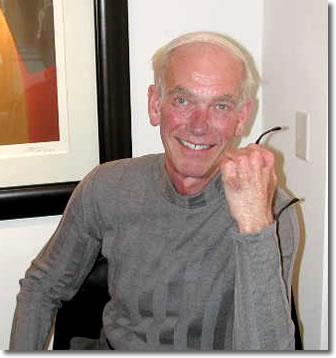 would
say. But these guys are believers in what they sell, not just mouthpieces
for the gallery. Russell says he is drawn to Kipniss partially by the
nostalgia that his pieces evoke. "Having grown up in
a small town in Oklahoma back in the 50s when it was very safe to walk
home from school at night, some of the scenes that he's captured, like
backyard scenes or alleyways with the moonlight, they bring such wonderful
memories. You aren't worried; you knew who lived in those houses."
would
say. But these guys are believers in what they sell, not just mouthpieces
for the gallery. Russell says he is drawn to Kipniss partially by the
nostalgia that his pieces evoke. "Having grown up in
a small town in Oklahoma back in the 50s when it was very safe to walk
home from school at night, some of the scenes that he's captured, like
backyard scenes or alleyways with the moonlight, they bring such wonderful
memories. You aren't worried; you knew who lived in those houses."
Some of Kipniss work is a little eerie too. Says Russell, "I call them happily haunting ... But that's what makes them more interesting. They are not fluff."
Taking it to a deeper level, Russell says some people see Kipniss as only landscape. But he says there's more there: "The trees and sheds are metaphors for other things in his world. Once you get past the tree—yes, that is a tree—and you look at it as a sort of symbol of growth and blossoming and leaves growing and filling space, it's sort of a metaphor for life. I find that very appealing."
Maybe that is my problem. I'm lacking the right metaphor. I search for meaning but don't find it.
But maybe there is some meaning here. Let's see.
The other day I had the honor of attending a Balboa High School party for a book published by some of the students there. The book is called "I Might Get Somewhere: Oral Histories of Immigration and Migration." The stories are interviews by students. Most of the students are immigrants themselves or sons and daughters of immigrants. Most of them took the obvious approach and interviewed their mother or father or an aunt or uncle. Most of them discovered things they never knew about their relatives. "Follow That Balloon" is an interesting one. It is the story of a young Mexican woman coming to the United States, aided by coyotes, whom you pay to help get you across. At the border she is told by the coyotes that she will have to hand over her daughter to a stranger who will get her across. She is told it is too difficult to get two people across at the same time. She hands over her daughter but is sick with worry. Already anxious about crossing, her anxiety is now doubled. They tell her when she gets across she will find her daughter by looking around town for a red balloon. She makes it across, does find her daughter, and all is well. But as you read the story her anxiety becomes yours; it is a story of taking a chance of losing the most precious thing you have. She has many other struggles coming here to live.
Author Amy Tan wrote the forward for the book and also
addressed the students at the party. She talks about voice and storytelling.
She says, "Often 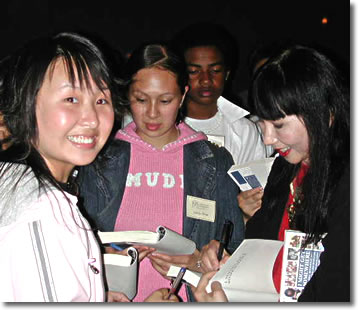 the
voice has a secret past, what has never been told, but usually because
no one has asked or no one was there to listen."
The stories in "I Might Get Somewhere" fortunately have interested
listeners and the past is revealed and experience shared. The heart of
the reader grows.
the
voice has a secret past, what has never been told, but usually because
no one has asked or no one was there to listen."
The stories in "I Might Get Somewhere" fortunately have interested
listeners and the past is revealed and experience shared. The heart of
the reader grows.
I was invited by a young Chinese student who has been here about a year. She came because her mother was sick. She had no other relatives here. Then her mother passed away. She has a story to tell someday. But for the book she wrote a story about another person's coming to the United States.
Afterwards Tan signs copies of the book for the students. Tan has no children of her own but at this book party she has a very large family, some from China, some from Vietnam, some from Cambodia, some from Mexico, some from Nicaragua .... Her presence nurtures them all.
Who needs Correction? At times we can all use some. Got a correction on a story I wrote about a trip I took. (Escape From the City: Paris, Puigcerda & La Comida Fantastica.) Concerning the town of Llivia, which I wrote about—it's located in France but considered Spanish—I stated:
Apparently a battle was fought there years ago and the Spanish won. These days no one feels like a rematch, so it's considered Spanish.
While I was not trying to be historically accurate, and in some ways did not really want to know the truth, the truth does have a way of coming out. A French reader, Etienne Dunant, who knows his history informed me:
I just wanted to explain the ‘spanish town in France' thing that you tell in your account of Cerdanya. I know that it was not your main interest, but I have been spending most of my holidays in this region since I was a child, and I am always happy to share a bit of history about this region I love. I won't be too long because I don't want to bore you. Just know that back in the 17th century, at the end of a war between France and Spain (France won it by the way), it was decided to draw a frontier between the two countries that couldn't be disputed afterwards. It was actually one of the first fixed frontiers in Europe. Most of them were not clearly established, and the locals didn't bother, being far away from the capital cities. For Cerdanya (Cerdagne in French), a river was taken as a natural frontier. You still cross the river when you leave Puigcerda and you go to France. It was also decided that the towns of the valley were to be Spanish. Llivia was one of them, but it was not realized it was at the wrong side of the river. Thus making Llivia Spanish, but surrounded by French lands, and this is still the case.
Sounds like a nice mixup that would aid immigration. Also I like the little detail pointed out by Etienne that France won. Do I hear a little parenthetical pride? Perhaps.
Actually I can't wait to get back. The food is wonderful and the country side beautiful to look at. If I can just get a green card ...
Immigration Problems? Actually I have a lot of friends with immigration problems. You can get into the United States with some trouble, but then you have the problem of wanting to leave to visit relatives. Leaving is not the problem; you can do that. The problem is coming back. On the young this is tough. Maybe you even have a child, who for one reason or another, is living in the country you left behind, and not being able to visit that kid is breaking your heart. But if you do, they got you. You can't get back in. It's even worse these days with George Bush in office. Bush doesn't need to visit his daughters in some dusty little town where they are picking coffee beans for the United States, sewing garments in a basement, or working in a semiconductor fab and breathing fumes ...
Now don't get me wrong. I love coffee, I wear clothes gladly most of the time, and I have a nice love-hate relationship to my computers. But there are limits to how much other people must suffer for my pleasures.
These days I'm not sure why anyone wants to come here. Maybe to get away from the mayhem we're causing in their country.
Nevertheless, the other day a young lady offered me $3,000 to marry her and end her immigration problems. She misses her mother and father and would like to go visit them in Thailand. "Let's go see a lawyer," I said. "There must be a better way for you than this." She is twenty-seven; I'm somewhat older.
I think there must be some excitement being here illegally, however. For me it is boring; no one is looking for me; no one is going to deport me if I get a traffic ticket. In short, no one cares about me other than a handful of bill collectors. But for those who are here with a question mark, there may be some adventure. Life is always on the edge and you have to be alert. You take nothing for granted and so you are really alive.
Do You hear music? Do you
hear a song? I do. That's because Eric Shifrin has
a new CD out. Eric has multiple personalities. He is the dream music
of the Fairmont Hotel, playing American song-book classics that 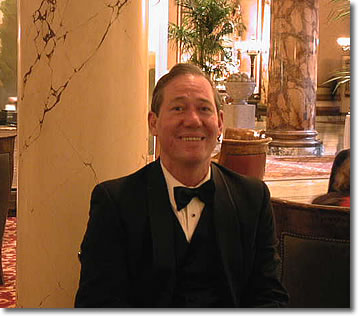 transport
you to another time and place; he is the big-band guy who not only plays
piano but alto sax as well and once studied with the most underrated
sax player ever, Warne Marsh; he is the gravelly voiced singer and piano
player of the Washington Street Bar & Grill and Enrico's in North
Beach. And I'm sure I will discover other personalities as well. The
new CD is more or less a sequel to the last; it is the dream music he
plays at the Laurel Court in the Fairmont Hotel but recorded in fact
at Idyllwild Brewing Company, where recoding conditions are somewhat
more favorable than in the Laurel Court. While the first
CD contains some of the greatest classics ever, the second contains some
of the lesser-heard classics, such as "Don't Explain." Know
that one? Billie Holiday sings it like no one else can. Billie has "chops"
but not the chops of say Sarah Vaughn. But no one sings this like Billie.This
song is my life.
transport
you to another time and place; he is the big-band guy who not only plays
piano but alto sax as well and once studied with the most underrated
sax player ever, Warne Marsh; he is the gravelly voiced singer and piano
player of the Washington Street Bar & Grill and Enrico's in North
Beach. And I'm sure I will discover other personalities as well. The
new CD is more or less a sequel to the last; it is the dream music he
plays at the Laurel Court in the Fairmont Hotel but recorded in fact
at Idyllwild Brewing Company, where recoding conditions are somewhat
more favorable than in the Laurel Court. While the first
CD contains some of the greatest classics ever, the second contains some
of the lesser-heard classics, such as "Don't Explain." Know
that one? Billie Holiday sings it like no one else can. Billie has "chops"
but not the chops of say Sarah Vaughn. But no one sings this like Billie.This
song is my life.
Hush now, don't explain
Just say you'll remain.
...
You know that I love you
and what love endures
...
Cry to hear folks chatter
and I know you cheat ...
It is a sad, lonely, depthful song and without singing it, Eric evokes its complex feeling.
Frankly, when I first heard Eric at the Fairmont, I thought he was good but limited to hotel lobby music. Having explored his other sides, I know him to be much bigger than this. He is complex and soulful. While his first piano CD sparkles like a diamond, this one glows like a ruby.
Question? So let me ask you this: You have dodged bullets, starved while waiting to cross the border, broken into a sweat while you presented an expensive passport produced by a con artist, and maybe handed over your first born ... So what now? Do you listen to the music of the new country and become spellbound by it? Do you go a little nuts and feel confused and dizzy? Or do you bring your music with you and keep it alive by humming it wherever you are? Do you get boozed?
You're here, I'm here, and we all have something to do. Survive, have a dream, write a poem, say I love you, get mad, get lost, get high, come to your senses, say I love you again.
I love you. Now don't explain.
Home | City Notes | Restaurant Guide | Galleries | Site Map | Search | Contact \